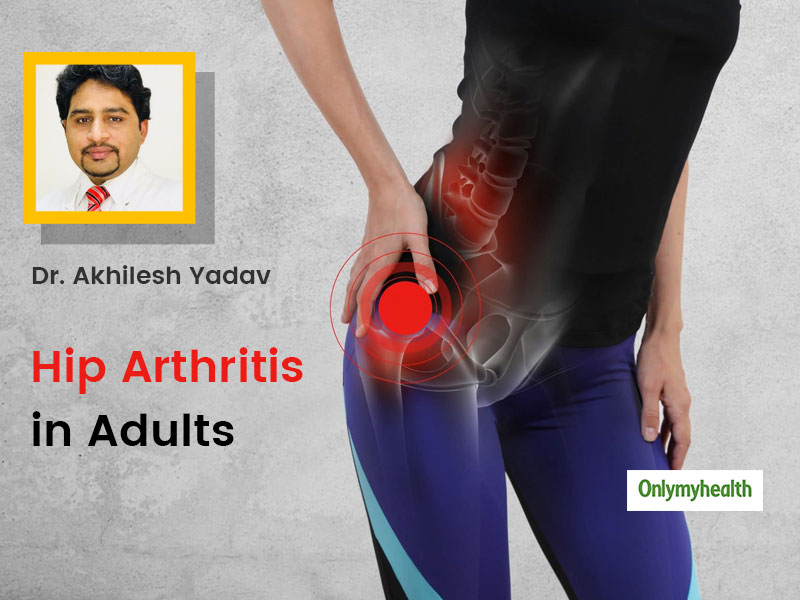
Winters are here! Colder days might feel good but this isn’t pleasing for your body. Reduced temperature affects blood circulation in the joints that trigger arthritis pain. Also, vitamin D levels tend to lower during winters due to less sunlight that also contributes to the weakening of joints and bones. This gradually develops into arthritis condition. Hip pain during winters is a sign of hip arthritis that is highly common with younger adults. Onlymyhealth contacted Dr. Akhilesh Yadav, Senior Transplant Head Joint Replacement(Hip & Knee), Centre for Knee and Hip Care, Vaishali to know more about the risk of hip arthritis, its causes, prevention and treatment.
Table of Content:-
What is hip arthritis?
When the space between the hips starts to narrow and tissues around the hips begin to shrink, arthritis is caused. Mostly, this occurs due to hereditary or genetic reasons but there are various other conditions like obesity, intensive exercising and joint wear and tear that cause hip arthritis. Back pain also mimics hip arthritis.
The hip joint is highly mobile and is formed like a ball and socket. In arthritis conditions, the joint gets stiff and causes acute pain as we move. Therefore, hips arthritis is difficult to bear.
Types of hip arthritis

Three most common types of arthritis that can affect the hip joint are:
- Osteoarthritis- Most often affecting the elderly population
- Rheumatoid arthritis- Very common among youngsters
- Ankylosing spondylitis- Very common among youngsters
Youth who take bodybuilding supplements and steroids are highly likely to suffer from hip and joint problems. Let us talk about hip arthritis types in detail.
Also Read: Can Patients Of Arthritis Do Pilates? Know From Pilate Expert Vesna Jacob
Osteoarthritis
This is the most common form of arthritis seen especially in elderly people. Although it is also caused due to structural problems with the hip joint, advancing age, obesity, hip injury, etc. Obesity is one of the major causes of Osteoarthritis and knee-related ailments, where knees undergo 6 times the bodyweight thereby affecting the joints.
Rheumatoid Arthritis
Rheumatoid arthritis not only affects the hip joints but your entire body. This is an autoimmune disease that is majorly seen in older women. RA and stress-induced arthritis causes inflammation and pain in both hips and over time damages bone and cartilage of the hip joints.
Ankylosing spondylitis
It is a chronic inflammation condition of the spine and sacroiliac joint (the joint where the spine meets the pelvis). This occurs mostly in people between 17 to 35 years and men are more likely to get this as compared to women.
Also Read: Rheumatoid Arthritis Patients Are At Greater Risk Of Developing Diabetes

What are the symptoms of hip arthritis?
Common symptoms associated with hip arthritis are:
- Pain in the hip joint that includes the groin, outer thigh and buttocks
- Pain is worse in the morning and lessens over the day
- Difficulty walking
- Stiffness in the hip
- Pain over back and radiating to knee through the front of thigh
How is hip arthritis diagnosed?
If you suspect of having arthritis of the hip, get a diagnostic evaluation immediately. This may include:
- Your medical history and physical examination
- X-rays can help in determining abnormalities in the joint.
- Blood tests
Based on the results, the doctor would suggest the best possible treatment for arthritis that may include:

Non-Surgical Options
- Anti-inflammatory medications
- Physiotherapy or exercise programs to improve flexibility and muscle strength
- Swimming is an excellent exercise for arthritis
- Weight reduction in case of overweight patients
- Devices such as canes/walkers to make it easier to walk
Surgical Options
Minimally Invasive Hip Replacement Surgery: It is an appropriate treatment option if the hip joint is severely damaged or if pain and swelling reduce motion in joints and affects the quality of life. Hip replacement surgery is one of the most successful modern orthopaedic surgical procedures and it is performed with smaller incisions which mean quicker recovery. During a hip replacement surgery, the surgeon removes damaged cartilage and bone from the hip joint and replaces them with man-made parts.
Read More Articles in Other Diseases
Also watch this video
How we keep this article up to date:
We work with experts and keep a close eye on the latest in health and wellness. Whenever there is a new research or helpful information, we update our articles with accurate and useful advice.
Current Version